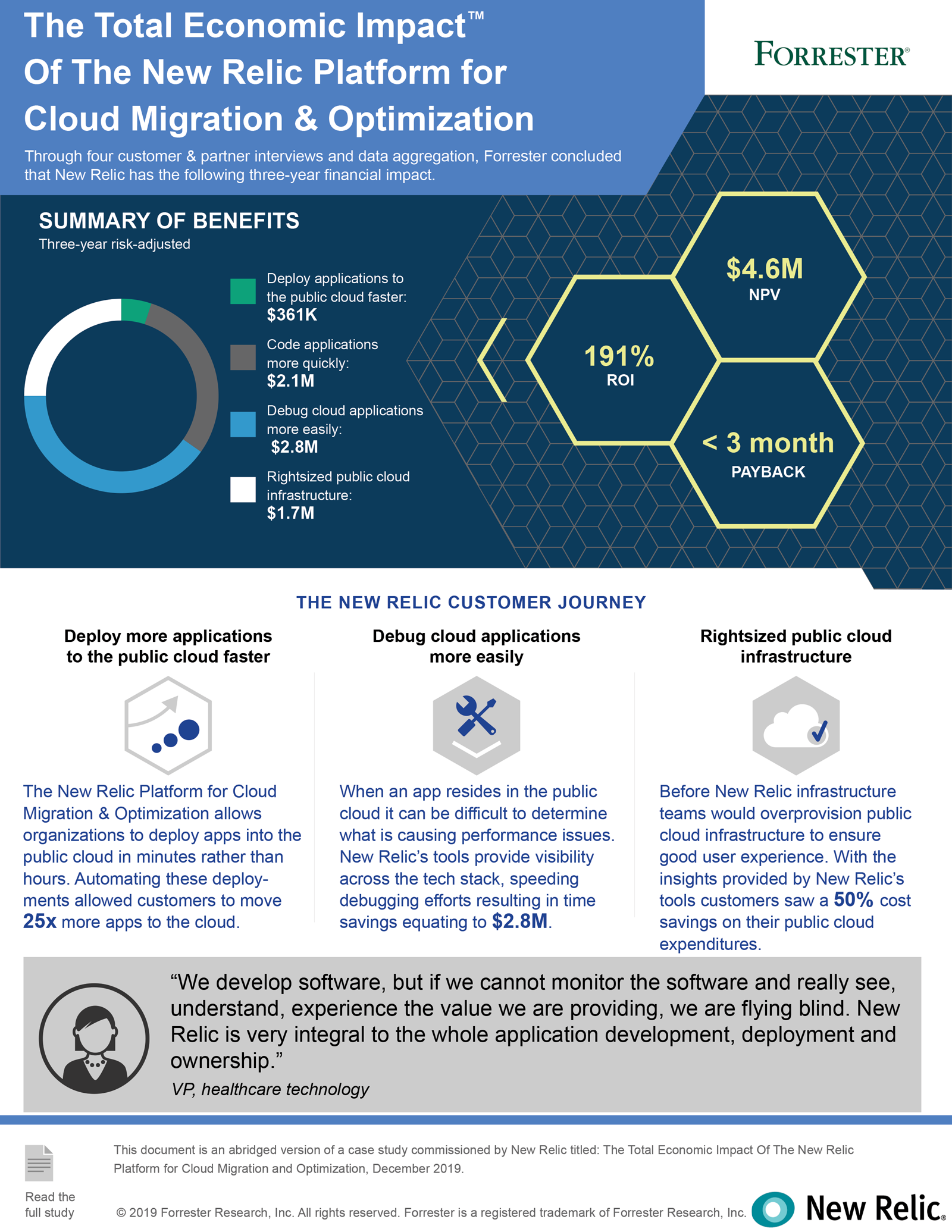Key Benefits
-
Deploy applications to the public cloud faster:
90% time savings
95% cost savings -
Debug cloud applications more easily:
$2.8 million PV -
Rightsize public cloud infrastructure:
50% cost savings
Key Findings
-
ROI
191% -
Benefits PV
$7.0 million -
NPV
$4.6 million -
Payback
< 3 months
Quantified benefits.The following risk-adjusted present value (PV) quantified benefits are representative of those experienced by the companies interviewed:
-
Deploy applications to the public cloud 90% faster with 95% lower cost.
With New Relic, organizations can deploy applications to the public cloud daily or several times a day instead of monthly. The deployment takes minutes, not hours, and can be managed by a small team, often just one person. By mapping application dependencies premigration, companies avoid errors and outages.
-
Code cloud applications more quickly, $2.1 million PV.
Once companies have deployed the New Relic Platform, cloud application developers can write cloud application code better and faster. The New Relic tools help the developers understand application dependencies and potential issues. Cloud application developers save 30% of the time they spent writing cloud application code. Overall, the organizations require fewer resources for cloud application development.
-
Debug cloud applications more easily, $2.8 million PV.
With New Relic, companies now measure time spent debugging cloud applications in minutes instead of days or weeks. An application residing in the public cloud could be causing performance issues — or issues could be caused by the underlying public cloud infrastructure. New Relic’s tools look across the companies’ tech stacks and help the infrastructure teams and developers identify the source of each problem, speeding resolution.
-
Rightsize public cloud infrastructure and cut costs by 50%.
The New Relic tools ensure that spending on public cloud infrastructure is only what is needed.
Unquantified benefits. The interviewed organizations experienced the following benefits, which are not quantified for this study:
-
Realized the benefits of public cloud sooner.
The New Relic Platform for cloud migration and optimization helps organizations move their applications into the public cloud more quickly. As the interviewed organizations moved applications into the public cloud, application availability, reliability, and scalability improved. The infrastructure teams closed data centers, saving costs. Companies needed fewer engineers to support cloud applications than their on-premises applications.
-
Simplified tech stack performance management.
New Relic dashboards look across the tech stack. IT teams no longer need to jump between multiple dashboards or be trained on multiple tools; instead, they use a single New Relic dashboard.
Costs. The interviewed organizations experienced the following risk- adjusted PV costs:
-
New Relic license and services fees, $1.6 million PV.
The organizations use the New Relic tools for both application performance management (APM) and migration of applications to the public cloud. Forrester has prorated the representative cost of the New Relic annual license fee to reflect the amount of time the tools are used for application public cloud migration and optimization. On average, companies use the tools 30% of the time to support public cloud migration.
-
Internal staff to support New Relic tools, $821K PV.
Internal staff support the New Relic Platform and manage the public cloud rightsizing program.
Forrester’s interviews with four existing customers and partners and subsequent financial analysis found that an organization based on these interviewed organizations experienced benefits of $7.0 million over three years versus costs of $2.4 million, adding up to a net present value (NPV) of $4.6 million and an ROI of 191%.

